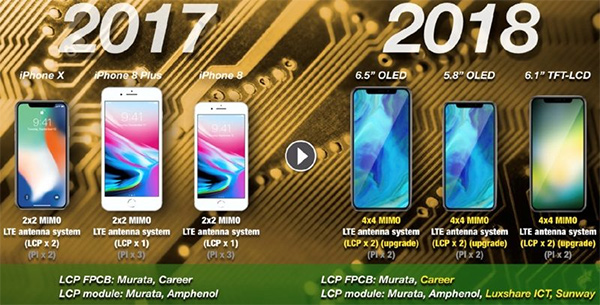KGI Securities analyst Ming-Chi Kuo has reappeared with another prediction about Apple’s next-generation iPhone range.
The prominent and often-accurate analyst is now focusing on the future of Apple’s hardware, suggesting that the company’s next flagship will arrive at market with liquid crystal antenna modules which are designed to offer faster LTE transmission speeds to consumers.

In a research note issued to investors, Ming-Chi Kuo has suggested that Apple will update the design of its iPhone antenna system to include improved liquid crystal polymer LTE modules which are capable of delivering significantly improved LTE transmission speeds. The information suggests that the new iPhones will come with two antenna modules, similar to the current iPhone X flagship, but based on LCP technology to support 4×4 MIMO standards:
Antenna design upgrade a key factor in anticipated boost to LTE transmission speed in new 2H18F iPhone models. As a LTE antenna FPCB material, LCP is superior to PI in properties related to high-frequency, thermal performance and moisture resistance. We predict 2H18 new iPhones will be equipped with two LCP LTE antenna modules same as iPhone X or more, but with higher specs to support 4×4 MIMO standards.
This new research note follows on from Kuo’s predictions last week that Apple will upgrade to Intel’s XMM 7560 and Qualcomm Snapdragon X20 modems in its next wave of smartphones, a move which is designed to enable faster LTE transmission speeds. Both of those modems offer support for 4×4 MIMO technology. This will allow faster LTE speeds by increasing the number of data connections which are possible between the device and the connected cell tower. Moving from 2×2 MIMO to support for 4×4 MIMO essentially doubles the connections.

This new technology will presumably be made available in the three iPhone models Apple is said to be working on for a 2018 release. Those models are said to include a 5.8-inch OLED model which would essentially be a second-generation iPhone X, a larger 6.5-inch OLED version which would likely be referenced as a “Plus” sized iPhone X model, and a 6.1-inch LCD model which will appeal to the lower-end of the market with a reduced price point.
All of those devices will reportedly have the edge-to-edge display experience as well as Face ID and faster LTE speeds if today’s research note is to believed.
(Via: MacRumors)
You may also like to check out:
- Download GBA4iOS 2.1 iOS 11 IPA On iPhone Or iPad [No Jailbreak Required]
- vShare iOS 11 Download For IPA Files [No Jailbreak Required]
- Windows 10 Product Key And Activation: How To Find It And How It Works
- Pokemon Go 1.51.1 IPA And 0.81.1 APK Hack Available To Download Now
- Download Snapchat++ iOS 11 IPA With Notifications Fully Working [No Jailbreak Required]
- Download iOS 11.1.2 IPSW Links And OTA Update For iPhone, iPad, iPod touch
- Downgrade iOS 11 / 11.1.2 On iPhone Or iPad [How-To Guide]
- Jailbreak iOS 11 / 11.1.2 / 11.1.1 On iPhone And iPad [Status Update]
You can follow us on Twitter, add us to your circle on Google+ or like our Facebook page to keep yourself updated on all the latest from Microsoft, Google, Apple and the Web.

